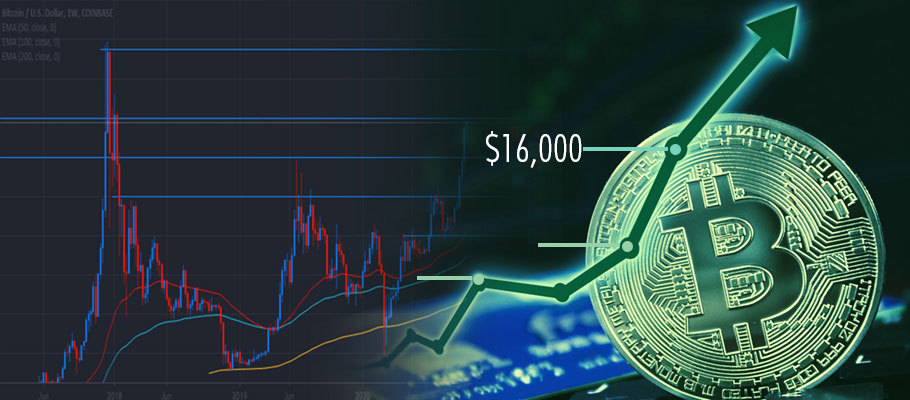
Published: November 20th, 2020
Bitcoin touched above USD 16,000 USD last week, the first time its crossed that threshold in three years. Its recent highs represent a 28 per cent jump in value in the previous three months alone.
BTC has been shooting upward since March when it dropped sharply to lows of around USD 4,000. Since then Bitcoin has bounced back to reach the crucial USD 10,000 price point and beyond, climbing to its recent highs, which reflect values that haven’t been seen since its 2017 bull run.
This time, however, the drivers behind Bitcoin’s rise are different. Institutional investors are making their presence felt, and at the retail end, it's easier than ever to buy Bitcoin now that PayPal has opened its doors. Bitcoin inflation levels have also dropped by half.
All of these factors have dovetailed to create stunning second BTC bull run. Here’s how it all started.
Things began to ramp-up for Bitcoin in August of this year, when global business intelligence giant MicroStrategy invested a whopping USD 425 million in BTC. A USD 50 million Bitcoin buy followed that by payments tech company Square in October.
Since those moves, both MicroStrategy and Square have seen big profits of 45 per cent and 54 per cent, with each company’s Bitcoin position now worth USD 620 million and USD 75 million.
Not surprisingly, both companies have become outspoken advocates for BTC. MicroStrategy CEO Michael Saylor called Bitcoin ‘digital gold, and said the world’s leading coin is ‘stronger, faster, harder, and smarter than any form of currency that’s existed before.’
Square’s CFO Amrita Ahuja has said the company believes Bitcoin has the potential to be a mass-market form of payment, and Square’s BTC purchase is an investment in the future of payments.
Those cheerleading statements have been followed by public support from other sections of the investment world, including some of the biggest names on Wall Street.
Hedge Fund big beast Paul Tudor Jones has described buying Bitcoin as similar to being an early tech investor, while no less than JPMorgan, whose CEO described Bitcoin as ‘a fraud’ in 2017, said in October that Bitcoin is competing with gold and has ‘considerable potential for long-term upside.’
Billionaire investor Stanley Druckenmiller is another convert. Previously critical of Bitcoin, he’s recently said that BTC ‘might just be better than gold.’
With stalwarts from traditional finance singing Bitcoin’s praises, institutional investors are starting to follow suit.
Global asset manager Grayscale is now one of the leading providers of custodial services for high-net-worth holders of BTC.
It’s been reported that the firm has recently acquired more than 40,000 Bitcoin, a position valued at over USD 600 million for clients. And it’s not the only one.
Grayscale and CashApp, a mobile payments service owned by Square have collectively purchased the equivalent of half the total Bitcoin mined in the first quarter of 2020.
Those moves have happened so quickly that sit prompted worries that Bitcoin might soon be in short supply, making it inaccessible to average investors. And there are other supply pressures.
The four-year Bitcoin halving cycle cuts in half the amount of BTC miners get back for adding new blocks to the coin’s blockchain. The last halving occurred in May 2020, meaning only half as much Bitcoin was being created as in previous months.
Halving the stream of supply means miners put fewer Bitcoin up for sale. That exacerbates supply shortages and also has an effect on pushing up Bitcoin’s price.
That, of course, is simply the law of supply and demand playing out. Basic economics touches on Bitcoin mining and extends to the broader cryptocurrency industry as a whole. If demand remains consistent, but supply is decreased, the two combined put upward pressure on the price.
It’s as simple as the price of pears in a market. If this year's pear harvest is especially robust, then pear prices will be expected to fall. But if pears turn out to be scarce due to weather conditions, infestation, or other things that lead to a poor harvest, then prices of pears go up.
All of these factors have come together to push Bitcoin’s price upward over the last six months, but one major factor that could lead to mass Bitcoin adoption could be the most significant of all.
International payments giant PayPal announced in October the addition of cryptocurrency buying and selling features on its platform. This week it confirmed that customers now have the power to buy Bitcoin. PayPal also announced plans to bring crypto buy & sell services to Venmo, its mobile payment platform.
PayPal’s new crypto features extend to buying and selling Bitcoin, as well as Bitcoin Cash, Ethereum, and Litecoin.
Combined with the nod of approval from traditional finance industry leaders like Grayscale and MicroStrategy perceptions of Bitcoin as a safe and legitimate asset are on the rise. PayPal’s entry to the market suggests a line has been crossed in terms of mainstream consumer acceptance.
‘Just bought Bitcoin with Paypal’ has become a trending phrase on Twitter. That’s a long way from PayPal’s previous stance which was to question Bitcoin’s suitability and longevity, Now that its jumped on the Bitcoin bandwagon, demand for Bitcoin, and its price, are likely to keep rising.